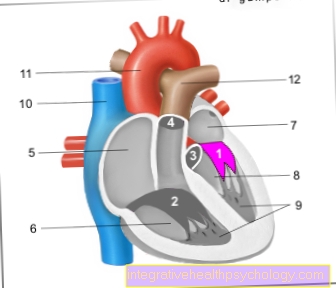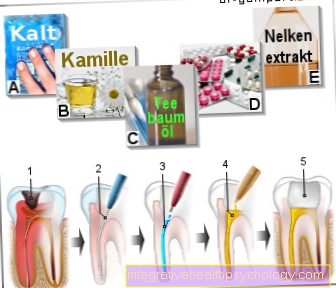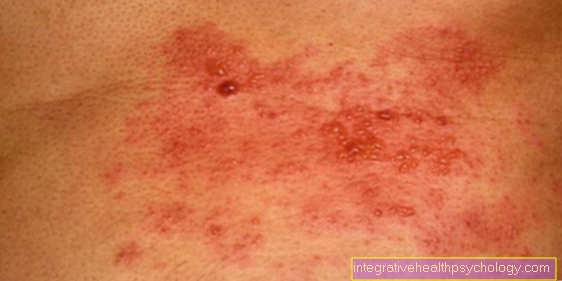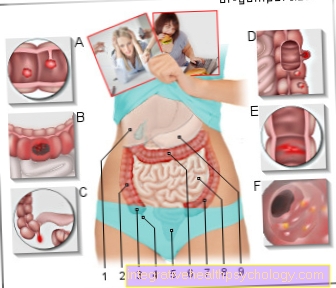Symptoms of HIV infection
Infection with the virus
A few days to a few weeks after infection with a sufficient number of HI viruses (=incubation period) there is an explosion of HIV, especially in cells of the mucous membranes, but also in the blood. The risk of transmitting the virus itself is due to the high viral load (Number of HIV viruses in the blood), which reaches its peak in this phase, is particularly large.
Do you have an HIV infection? Test this very easily - also possible at home - with the HIV rapid test. Further information on this topic can be found at: HIV rapid test - you should know that!

T-cell drop
The number of important immune cells, T cells, decreases sharply. This rapid deterioration in the immune system results in many, although not in all cases, a clinical picture that resembles other viral diseases, such as Pfeiffer's glandular fever. Fever, body aches, swelling of the lymph nodes and other relatively non-specific symptoms may occur. For this reason, inquiries about possible risks for HIV should not be dispensed with, even if a banal infection initially seems obvious.
Following this acute infection, the body creates an immune response that suppresses HIV but cannot remove it, reducing the number of viruses. Antibodies against the virus are formed. This no-symptom phase can last for several years. During this period, the number of T cells decreases slowly but continuously. If it has fallen below the critical limit of 200 pieces per mycroliter, the typical symptoms appear, which are caused by a weak immune system. From this point on, one speaks of AIDS. Nevertheless, the first signs of AIDS can appear even with a higher number of cells.
Classification of symptoms of HIV infection
There are certain typical infections which usually do not occur in people with an intact immune system, but which are conspicuously common in HIV or AIDS patients. Due to the lack of the important T cells, the immune system is no longer able to take targeted action against pathogens that are easily and quickly eliminated in healthy people.
These include, for example, yeast infections in the mouth and throat or certain pathogens causing pneumonia. The type of pathogen is just as specific and informative with regard to the progression of the disease, as is the number of T cells that are becoming fewer.
For this reason, a system for classifying AIDS has established itself which takes both into account. The so-called laboratory category, i.e. the T cell count, is divided into three levels.
- Level 1:> 500 / µl (microliter)
- Level 2: 200-500 / µl
- Level 3: <200 / µl
In addition, certain pathogens go into the so-called clinical category. Category A means that no HIV-specific symptoms are observed. Category C includes pathogens that define AIDS because they only occur in patients with a severely weakened immune system. This includes many fungal and worm diseases. But certain types of cancer are also common. Category B, on the other hand, stands for diseases which can provide an initial indication of the onset of AIDS, but which are not defining, i.e. proving. This includes, for example, shingles. In order to be able to assess the course and prognosis of an HIV patient, a combination of laboratory and clinical categories is necessary.
Symptoms of the acute phase of HIV infection
The first defense reaction of the body to the intruder is called the acute phase of HIV infection. It manifests itself through a variety of symptoms and principally serves to fight the virus - in the case of the HI virus, however, this is not entirely successful. The acute phase begins approx. 1-6 weeks after the virus enters the body. Only every second to third affected person goes through it. This means that the majority of those infected with HIV do not show any acute symptoms that would alert them to the disease at an early stage. That is why the infection with the HI virus is often diagnosed late.
When symptoms occur, they are often similar to the symptoms of "Pfeiffer's glandular fever" or the flu: Sick people often complain of fever and sore throat, swollen tonsils and aching limbs. Lymph nodes in several parts of the body can be swollen. Lymph nodes also show other signs of inflammation such as pain, reddening and overheating more rarely. Occasionally a rash occurs.
The symptoms can also be reminiscent of a gastrointestinal infection: diarrhea with thin to watery stools lasting several days can occur. In addition, nausea, sometimes even vomiting, can develop. Some of those affected lose more than 2.5 kg of weight in this phase of the disease.
As with Pfeiffer's glandular fever, infection with the HI virus can cause swelling of the spleen. This can occasionally be noticed by left-sided abdominal pain or in the physical examination at the doctor, but is usually only seen in an abdominal ultrasound.
Some patients describe muscle pain. This can affect many muscles at the same time and often starts in the arms or legs. Joint pain, for example in the knees, hips or elbows, also occurs occasionally. More rarely, but also possible, are headaches and other signs of meninges or meningitis such as tiredness, impaired consciousness, paralysis of the face or stiff neck.
As a rule, the symptoms subside after a few weeks at the latest, when the body has found the virus strong enough to suppress it. The lymph node swellings are an exception. They can persist months after the other symptoms have subsided - then, if the disease has not yet been diagnosed, they are an important indicator of the HIV infection.
The unspecific symptoms of the acute phase are described in more detail below.
stomach pain
Abdominal pain is a very unspecific symptom that occurs in all stages of HIV disease and can have many different causes. In the acute phase, symptoms of a gastrointestinal infection can cause the pain. Spleen swelling due to the infection can also be responsible for left-sided lower abdominal pain. In the course of the disease, abdominal pain can occur again and again, which cannot necessarily be assigned to a cause or requires treatment. Often times, opportunistic gastrointestinal infections with diarrhea are behind it.
Since in most cases the cause of abdominal pain is not HIV, we recommend our website: Abdominal pain - that's behind it
to cough
Coughing can be a typical early symptom of HIV infection, but it can also appear as an accompanying symptom in later stages of the disease. The acute symptoms of HIV infection themselves usually appear within a few weeks after the virus has multiplied in the body. These symptoms are similar to those of a conventional viral infection and can include cough, fever, and diarrhea. Long-term HIV disease can lead to so-called “opportunistic infections” due to the resulting immune deficiency. Here, too, coughing can be a symptom of HIV disease. If there is a spontaneous cough and other signs of infection with an existing HIV disease, a doctor should be consulted as soon as possible, as infectious diseases can sometimes take on severe courses and pneumonia is more likely.
fever
Fever is a very unspecific symptom and can indicate many diseases.
High fever occurs within the first two months after infection with HIV, i.e. the initial stage of the disease - often together with other general symptoms. But even later in the course, when the disease has reached an advanced stage, recurring subfebrile temperatures (between 37.5 and 37.9 ° C) are common.
Read more on the subject under: Fever
skin rash
A rash can occur a few days to weeks after the HIV virus penetrated during the acute phase following primary infection. About 30-50% of patients are affected by skin changes shortly after infection. Along with fever and swelling of the lymph nodes, rashes are among the most common symptoms after the primary infection and usually begin 2-3 days after the onset of fever. They can be very versatile and vary from patient to patient.
The most common rash that is technically known as "maculopapular" occurs. This is shown by mostly red spots that appear slightly raised or knotty when touched with the hand. Often times, the rash resembles the changes on the skin of rubella or measles infection; the spots can be smooth, rough, or scaly to the touch. In people with dark skin, the spots are black or dark brown. Itching or burning pain occurs very rarely at the same time.
The spots can appear all over the skin at the same time or only affect specific areas such as the face, chest, neck, back or limbs. The rash is mostly limited to the face, neck and trunk - it rarely occurs on the arms and legs. In most patients, it disappears approximately 24-48 hours after it first appears. However, it can also last for 2 weeks. As a rule, it heals without consequences and does not leave any scars on the skin.
If a rash with fever occurs a few weeks after intercourse with a potentially HIV-infected person or after intravenous drug abuse with “needle-sharing”, the alarm bells should ring - these could be the first signs of HIV.
In stage B, dellus warts (molluscum contagiosum), about 2 mm in size, whitish-shiny pustules with a small dent in the middle, which are caused by a virus. They like to appear on the face, trunk and genital area.
Herpes zoster, a reactivation of the chickenpox virus, is somewhat more unpleasant and more common in HIV-infected people than in healthy patients. It manifests itself with about 5 mm large, reddened, fluid-filled and later encrusted blisters on the face or trunk and is accompanied by severe pain.
In addition to the rash on the skin, mucous membranes may show signs of HIV infection. Occasionally, small, sore spots develop in the mouth and genitals, which are also known as "ulcers". They usually heal quickly and leave no trace.
In addition, genital warts often develop on the anus and vagina of people infected with HIV.
You can find a lot more information under our topic: Rash in HIV, Dellar warts and Genital warts.
itching
Like numerous other unspecific symptoms, itching can be an indication of an acute HIV infection, but it can also be caused by concomitant diseases in later stages. A few weeks after the primary infection, unspecific infection symptoms such as cough, runny nose and fever can occur. Sometimes a rash also appears, which manifests itself as itching, redness and small lumps. These symptoms subside after a few weeks at the latest. Over time, however, opportunistic infections can attack the skin again, causing skin infections with rashes and itching. Typically, fungal infections, herpes viruses, various bacteria and malignant tumor diseases as a result of HIV disease can lead to itching of the skin.
diarrhea
Diarrhea is a very common and bothersome symptom of HIV disease. Chronic diarrhea is a non-specific symptom that can be primarily and secondarily caused by the virus. The virus itself can lead to long-lasting diarrhea when it is first infected through inflammation of the intestinal mucosa, which usually subside after a while. In the long term, however, so-called “opportunistic” intestinal infections are not uncommon. You can use the body's immune deficiency to trigger chronic and persistent inflammation of the entire gastrointestinal tract. The frequently accompanying liver diseases can also lead to diarrhea as a result of their involvement in digestion.
Night sweats
Night sweats are defined as night sweats that are so intense that you have to change your pajamas or even your bed linen at least once a night.
If there is an increased tendency to sweat with a fever, a viral or bacterial infection can be assumed. In addition to the acute HIV infection, this may be due to flu infections, respiratory or urinary tract infections and Pfeiffer's glandular fever.
More severe infections are also possible with advanced HIV disease, such as tuberculosis, meningitis or endocarditis.
Night sweats can, however, also occur in the context of so-called "B symptoms". In addition to night sweats, this includes weight loss, fever and other non-specific symptoms that can indicate a malignant tumor disease.
The cause could possibly be a blood or lymph cancer, but also a tumor disease, which can be promoted by the HIV virus. Night sweats can rarely be traced back to certain medications. Hormone-modifying agents such as thyroid medication can be behind this.
Antidepressants can also be responsible in this context.
Further information on this topic can be found at: Sweating at night - harmless or dangerous?
A form of the enormous weight loss in connection with the infectious disease AIDS is the "Cachexia" represent.
Enlarged lymph nodes
The lymph nodes play a special role in HIV infection and its detection - because symptoms such as swelling, pain or overheating of the lymph nodes are often the first sign of an HIV infection.
Most of those affected notice small lumps either on the neck, on the jaw, in the groin or in the armpits. These nodes grow to a diameter of up to about 3 cm. Unlike most other infectious diseases, the lymph nodes often remain swollen for a long time when infected by the HI virus.
In addition, unlike many other pathogens, only one lymph node station is not affected, but rather several body regions show symptoms in the lymph nodes at the same time very early on. However, generalized lymph node swelling is not only typical of HIV. It can also be used in other viral diseases, e.g. Pfeiffer's glandular fever, or a lymphoma, i.e. lymph gland cancer, occur.
Read more on the subject at: Lymph Node Swelling - What Evidence Is There It Is HIV? and glandular fever
Headache and body aches
Headache and body aches, fever and fatigue together form the symptom complex of so-called flu-like symptoms.
They are particularly typical of infections with the flu virus, hence the name.
However, they also occur within the first two months after an HIV infection, when the immune system is still trying hard to defend itself against the infection, and are part of the early stages of the infection.
With HIV, however, these symptoms usually last a little longer than with the flu.
Symptoms in the mouth
HIV infection can manifest itself in any phase of the disease with symptoms in and around the mouth. Since symptoms affecting the mouth often hinder eating and drinking, they play a special role in the life of those affected.
During acute HIV illness shortly after infection, some patients develop small wounds, also called "ulcers", on the lining of the mouth. They often resemble the well-known canker sores. In addition, a reddish, sometimes lumpy rash may become visible in the mouth during this phase.
Whether symptoms in the mouth occur in later phases usually depends on how severely the immune system is impaired by the virus. If the number of immune cells is low, bacterial infections of the oral mucosa and the gums occur more frequently. Herpes in the mouth and on the lips is then one of the most common diseases. Some bacterial infections can lead to the destruction and blackening of the gums without treatment.
Learn more about the topic at: Bleeding gums as a sign of HIV infection
Furthermore, the fungal infection in the mouth (stage B) with the pathogen "Candida albicans" is very typical in HIV. It creates a white border of fungal pathogens on the tongue, oral mucus and palate. The fungus should not be confused with another, frequently occurring whitish discoloration in the mouth - the so-called "oral hairy leukoplakia". Behind the complicated name is a whitish change in the mucous membrane cells on the edges of the tongue, which is caused by an infection with the Epstein-Barr virus.
Read more on the subject at: Fungal infection in the mouth
After a long period of illness, various tumor diseases such as "Kaposi's sarcoma" or lymphomas can occur in the mouth and cause severe symptoms there.
Yellow tongue
A yellow tongue can have many causes and is by no means typical of an HIV disease. The causes can range from poor oral hygiene, lifestyle and eating habits, to infections caused by pathogens. Some causes can be directly or indirectly favored by the HIV infection. Fungal or bacterial infections can cause the plaque and also cause pain and other signs of infection. Due to a reduced immune defense, they can be caused indirectly by HIV. Antibiotic treatment can also trigger yellowish coatings on the tongue as a side effect. Antibiotic treatments are becoming more frequent due to the increased susceptibility of HIV infected people, which can also lead to a yellow tongue. More rarely, changes in the liver are behind the color of the tongue. In the case of liver damage, in addition to yellowing of the skin, the eyes, nails, mucous membranes and tongue can also be yellow. More rarely, however, is a lack of trace elements behind the symptom. Iron or vitamin deficiencies can also cause a yellow tongue and thus indirectly through HIV.
In stage C, so-called Kaposi's sarcomas can also appear in the mouth, an AIDS-defining disease. It manifests itself as bluish nodules in the skin and mucous membranes, which can also be painful.
Bleeding gums
Bleeding gums are an unpleasant symptom that can be indirectly related to an HIV disease. In many cases the cause is inflammation of the gums or oral cavity, a so-called "gingivitis". It can arise from pathogens but also from food residues and poor oral hygiene. Before an infection is assumed, adequate oral hygiene should first be in the foreground. In the course of an advanced HIV disease, however, the weak immune system can also lead to bacterial or viral inflammation of the gums. Fungal infections of the oral cavity can often be associated with an HIV disease and trigger the bleeding.
For more information on this topic, we recommend our page on: Bleeding gums as a sign of HIV infection
Frequent comorbidities with HIV
hepatitis
Hepatitis infections are very common with HIV infections. Hepatitis is an inflammation of the liver, which in most cases is caused by one of the five hepatitis viruses. The infections are often found together because the transmission routes are the same. Both diseases can be transmitted through sexual contact, contaminated syringes, and blood contact.
If there is already an HIV infection, other viral inflammations can again occur more favorably, since immunosuppression facilitates both the initial infection and the chronification of hepatitis. The hepatitis B and C viruses in particular pose a great danger to the patient, and there is an effective vaccination against hepatitis B. Acute symptoms such as fever, yellowing of the skin, and nausea may rarely occur, but the infection is often only revealed through a routine blood test. Different types of hepatitis come with different treatments and prognoses. Drug therapy is absolutely necessary to prevent a chronic course of the infection and thus avoid severe liver damage in the long term.
Further information on this topic can be found at: hepatitis
depression
People with HIV suffer more often than average from depression, which is due to the severe psychological and physical stress caused by the HIV disease. For those affected, HIV infection is often a decisive experience in their lives. Nevertheless, the HIV disease is fraught with many prejudices that give those affected and the social environment a faulty picture of the disease and thus create psychosocial stress. The most important aspects of the HIV illness, which often lead to psychological stress, are the chronic course, the shortening of the lifespan and the supposed inability to maintain sexual contacts and have children. An HIV infection is chronic and cannot be cured, but drug control is so easy that the infection will not shorten life or even result in a death sentence. Sex life does not have to experience any significant restrictions under medical supervision. During the initial diagnosis, every person affected should receive psychotherapeutic support in order to remove stigmata, to better understand and get to know the disease and to quickly lead an everyday life again.
Typical symptoms in men
The HIV infection has hardly any gender-specific differences. Only the transmission routes and probabilities can vary between the sexes.
For men, the most important self and external protection is the condom. This results in less skin contact with a potentially infectious mucous membrane.
Overall, the risk of infection for men is lower during heterosexual intercourse. The course and symptoms in the case of acute and chronic HIV disease do not differ from those of a woman.
In the acute phase, swollen lymph nodes can appear in the groin area. The genital area itself can occasionally become sore.
The first symptoms in the first few weeks are therefore of a general and systemic nature and usually consist of: fever, malaise, diarrhea and weight loss (because of the diarrhea, HIV is also known as "slimming disease") and generalized swelling of the lymph nodes.
The opportunistic diseases caused by the damage to the immune system by the virus only appear months or years later. These then define the AIDS stage as a whole (acquired immunodeficiency syndrome).
Genital warts can also appear more favorably on the male genital through HIV infection. In the chronic course of the disease, the development of various malignant tumor diseases is favored by the immunosuppression.
While some gender-specific cancers can develop in women, anal, testicular and penile carcinomas are less likely to develop in men.
However, other viral infections and smoking play an equally important role in the development of these carcinomas. Fertility is generally not affected by HIV infection.
Even a conception is possible by so-called "washing" of the sperm in the laboratory.
Typical symptoms in women
While HIV infection is similar in both sexes, additional factors such as diseases of the female sex, desire for children, birth risks and social impairment caused by HIV must be considered in women.
In addition, there are some gender-specific diseases that occur more frequently in HIV-infected women than in healthy people and can severely limit the lives of those affected. These include, for example, inflammation and infection of the vagina, uterus and ovaries as well as sexually transmitted diseases caused by chlamydia and trichomonads.
Vaginal herpes occurs up to 20 times more often in people infected with HIV than in healthy people.
Another area that is important for HIV is tumor diseases. Regular preventive care is essential for women infected with HIV because the cells in the cervix change significantly more often and can thus trigger cervical cancer.
The better the condition of the immune system, however, the longer it takes for the virus to reduce the number of T cells.
However, in end-stage HIV disease, women may develop cervical cancer (cervical cancer) caused by HPV (human papillomavirus). To do this, however, an infection with HPV must have existed beforehand, which then leads to the transformation of the squamous cells of the cervix due to the immunodeficiency. This is the first disease caused by AIDS in many women.
Furthermore, in women who want to have children, it should be borne in mind that pregnancy is much more risky: Infections in the unborn child occur more frequently, the risk of premature birth is increased and transmission of HIV to the child is particularly possible if no precautionary measures are taken .
Serious illnesses in the late phase of HIV infection
An HIV disease runs in different stages and can present itself clinically very differently. After the acute stage has subsided, the disease can be controlled and run symptom-free, or it can lead to stages B and C. The stages are characterized by the occurrence of so-called opportunistic diseases. Primarily, these are infections with pathogens that would not have caused an infection in the immunocompetent or that would have had fewer symptoms. These include fungal infections in the mouth and esophagus, chronic diarrhea, tongue coatings from viruses, reactivation of viruses with painful rashes and numerous other diseases. All bacterial, viral or parasitic pathogens can lead to symptomatic infections with sometimes considerably more difficult symptoms due to the increasing immune deficiency of the HIV infected person. Stage C is followed by particularly serious opportunistic diseases, which is why this stage is called AIDS. These can sometimes be accompanied by neurological symptoms such as changes in personality, epilepsy, neuropathies, paralysis and sensory disorders. Pneumonia is also common at this stage, for example caused by tuberculosis pathogens. Malignant tumor diseases can also be a consequence of HIV disease. Over time, they can affect all organs and lead to very variable symptoms and complaints. In the following the most important opportunistic diseases that are favored by the HIV virus are named.
Kaposi's sarcoma
Kaposi's sarcoma is a malignant tumor that is one of the so-called "AIDS-defining diseases". This means diseases that clearly show that the HIV disease is in the end stage. With Kaposi's sarcoma, many tumors that are widely distributed in the body appear within a short time, which can be traced back to a group of herpes viruses. The HIV disease favors the subsequent degeneration of affected cells, which can lead to the heavily perfused nodes on the skin and all organs. Kaposi's sarcoma is dependent on the immune status and the HIV disease, which is why cancer therapy is mainly directed against HIV infection. As a rule, Kaposi's sarcoma is incurable.
Also read the main page on the topic Kaposi's sarcoma.
lung infection
Pneumonia is a common and dangerous clinical picture which is a dreaded concomitant disease in the context of an HIV infection. Pneumonia is caused by simple respiratory tract infections, which can often occur in people with healthy immune systems, especially in the winter months. However, due to the immune deficiency of an HIV patient, the inflammation can spread into the deep respiratory tract and the lungs. This leads to a high fever, cough and, not infrequently, life-threatening blood poisoning. The risk of pneumonia in people infected with HIV must always be considered, as it is one of the most common causes of death in immunocompromised patients. From a therapeutic point of view, it should be noted that the HIV disease can also cause pneumonia to be infected with unusual germs, such as tuberculosis pathogens.
Further information on this topic can be found at: Signs of pneumonia
Neuropathy
Neuropathy is a disease of the nervous system that is not caused by accidents. Various opportunistic infections that can occur in the context of HIV disease manifest themselves in the nervous system. The neuropathy can be caused by opportunistic pathogens, by the HI virus itself or as a side effect of the medication. Typical symptoms are slowly rising abnormal sensations in the feet and hands. Often the symptoms are trunk-shaped and migrate steadily towards the trunk. As a long-term consequence, the muscles in the affected area can even fail.
dementia
Dementia is a psychiatric abnormality that can result from changes in the brain. Typically only senile dementia is known, but neurological diseases and infections of the nervous system can also cause dementia. The HI virus itself can accumulate in the brain and lead to HIV dementia and structural changes in the nerve cells. Reduced intelligence and cognition, slowdowns, depression and motor disorders are the symptoms. However, dementia can also occur as a result of opportunistic infections caused by the immune deficiency. Infections that affect the nervous system, among other things, are, for example, "toxoplasmosis" or "cryptococcal meningitis". The infections can severely damage the central nervous system. Symptoms may decrease with early treatment.
You might also be interested in: Symptoms of toxoplasmosis
When do the symptoms appear?
When the first symptoms appear in an HIV infection is very variable. They only arise when the virus has multiplied sufficiently.
- In some affected people, acute HIV disease sets in shortly after the virus penetrates - it usually starts between 7 days to 6 weeks after infection, with the first symptoms such as fever, sore throat and swelling of the lymph nodes usually occurring between the second and fourth week. In the first two months after infection, general and unspecific symptoms of a severe infection appear (see below).
Latency phase that can last months and even years (stage A). In this latency phase, the infected person has few symptoms, at most he notices an increasing inefficiency and weight loss. The progressive destruction of capable immune cells can gradually lead to infections with pathogens that would not break out in a healthy person. These diseases are grouped together as AIDS-defining and non-AIDS-defining diseases. - After the latency phase, symptoms that do not define AIDS appear first (stage B).
- The occurrence of AIDS-defining diseases, which also lead to the diagnosis of AIDS, is to be expected no earlier than two years after infection (stage C).
- A rash often becomes visible 1-2 days after the first onset of fever. Another part of those affected notice thick, swollen lymph nodes in several parts of the body such as the neck, armpits and groin within a few weeks of infection, sometimes months later.
It should be noted that only some of those affected show symptoms in the first few years - with the rest of the infected, the virus remains unnoticed until tumors, general symptoms such as weakness, weight loss and impaired consciousness or so-called "opportunistic" infections - i.e. infections that only occur with weakened immune system arise - occur.
For these people, there is no specific time when symptoms first appear. A few notice the first symptoms within weeks or months, while others remain symptom-free for 15 years.
Symptoms almost never develop in the first 2 years. In every following year about 6% develop the full picture of the HIV infection. On average, it takes 8-10 years until then.
How do I know if I am imagining HIV symptoms?
You cannot really tell right away whether you are imagining an HIV infection.
The first question that you should answer honestly is whether you have shown so-called risk behavior. Above all, this includes unprotected sexual intercourse, i.e. without using a condom, with a partner whose HIV status is unknown to you.
The spread of HIV is greater among homosexual men and therefore the risk of infection is higher. Use of intravenous drugs, e.g. Heroin with already used utensils (so-called needle-sharing) also carries a considerable risk of contracting HIV or other diseases.
If one of these scenarios can be answered with yes, an infection with HIV cannot be ruled out.
The time frame and the constellation of symptoms are important for the diagnosis of HIV infection.
HIV / AIDS presents a diverse clinical picture, but typical is a certain sequence of symptoms over a certain period of time.
A single clinical picture, for example chronic diarrhea or generalized swelling of the lymph nodes alone, is not yet suspect of an HIV infection. However, if you can't get rid of the thought of being infected, you can anonymously have an HIV test carried out at any municipal health department, which will give you certainty.
Duration of symptoms
The various symptoms of the acute phase usually begin 1-6 weeks after penetration of the pathogen. In some patients, they disappear within days. For others, it takes weeks for symptoms to subside. The reason for this is that each person takes a different amount of time to develop an effective defense against the intruder. You can expect symptoms such as fever, sore throat and skin rashes to completely disappear after 1-4 weeks.
If the symptoms of the acute phase have subsided or - as in the majority of patients - never occurred, those affected are in the so-called "Latency stage". This can only Last a few months, many years, or a lifetime. Patients have no subjective complaints in this phase. Nevertheless, the virus spreads slowly and weakens the immune system.
In this case, how long it takes before further or first symptoms of the disease appear depends on various factors. Next to the Age, others Pre-existing illness and the genetic makeup of the virus and patient, it is also important how well the immune system was able to suppress the pathogen in the acute phase. In the best case, it lasts even without medication over 15 years until symptoms develop. In the worst case, it only takes months or a few years for AIDS-defining diseases to break out. On average, less than 5% of those infected have AIDS after 3 years, and about 50% after 10 years.
Before the full picture of the disease is reached, patients often feel one slow decrease in performance and lose weight. It can also increase due to the increasing immune deficiency Fungal infections of the mouth and the genitals as well as other infectious diseases. These diseases are usually well treatable. Although they are a sign of the progression of the disease, they do not represent the full picture of "AIDS".
With the help of today's drugs, the survival time and quality of life of almost all those affected can be significantly improved. If the therapy is started in young people before the onset of serious symptoms and taken consistently, this is the Life expectancy almost normal. This means that many HIV patients never get AIDS.





























